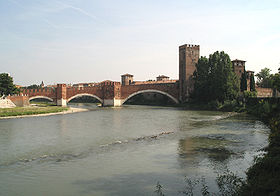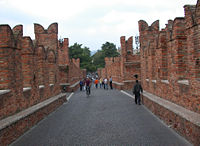
Castelvecchio Bridge
Encyclopedia

Italian language
Italian is a Romance language spoken mainly in Europe: Italy, Switzerland, San Marino, Vatican City, by minorities in Malta, Monaco, Croatia, Slovenia, France, Libya, Eritrea, and Somalia, and by immigrant communities in the Americas and Australia...
: Ponte di Castelvecchio) or Scaliger Bridge (Italian: Ponte Scaligero) is a fortified bridge
Bridge
A bridge is a structure built to span physical obstacles such as a body of water, valley, or road, for the purpose of providing passage over the obstacle...
in Verona
Verona
Verona ; German Bern, Dietrichsbern or Welschbern) is a city in the Veneto, northern Italy, with approx. 265,000 inhabitants and one of the seven chef-lieus of the region. It is the second largest city municipality in the region and the third of North-Eastern Italy. The metropolitan area of Verona...
, northern Italy
Italy
Italy , officially the Italian Republic languages]] under the European Charter for Regional or Minority Languages. In each of these, Italy's official name is as follows:;;;;;;;;), is a unitary parliamentary republic in South-Central Europe. To the north it borders France, Switzerland, Austria and...
, over the Adige River. The segmental arch bridge featured the world's largest span at the time of its construction (48.70 m).
History
It was built (most likely in 1354-1356) by Cangrande II della ScalaCangrande II della Scala
Cangrande II della Scala was Lord of Verona from 1351 until his death.In 1351, after the death of his father Mastino II della Scala, he inherited the lordship of Verona and Vicenza, initially under the regency of his uncle Antonio...
, to grant him a safe way of escape from the annexed eponymous castle
Castelvecchio (Verona)
Castelvecchio is a castle in Verona, northern Italy. It is the most important military construction of the Scaliger dynasty that ruled the city in the Middle Ages....
in the event of a rebellion of the population against his tyrannic rule. The solidity of the construction allowed it to resist untouched until, in the late 18th century, the French troops destroyed the tower on the left bank (although it probably dated from the occupation of Verona by the Visconti
House of Visconti
Visconti is the family name of two important Italian noble dynasties of the Middle Ages. There are two distinct Visconti families: The first one in the Republic of Pisa in the mid twelfth century who achieved prominence first in Pisa, then in Sardinia where they became rulers of Gallura...
or the Republic of Venice
Republic of Venice
The Republic of Venice or Venetian Republic was a state originating from the city of Venice in Northeastern Italy. It existed for over a millennium, from the late 7th century until 1797. It was formally known as the Most Serene Republic of Venice and is often referred to as La Serenissima, in...
).
The bridge was however totally destroyed, along with the Ponte Pietra, by the retreating German troops
Wehrmacht
The Wehrmacht – from , to defend and , the might/power) were the unified armed forces of Nazi Germany from 1935 to 1945. It consisted of the Heer , the Kriegsmarine and the Luftwaffe .-Origin and use of the term:...
on April 24, 1945. A faithful reconstruction begun in 1949 and was finished in 1951, with the exception of the left tower.
Architecture

Scaliger
The noble family of the Scaliger were Lords of Verona. When Ezzelino III was elected podestà of the commune in 1226, he was able to convert the office into a permanent lordship...
era, and in white marble in the lower one. It includes three spans of decreasing length starting from pentagonal towers. The largest span, measuring 48.70 m, meant that the bridge featured at the time of its construction the world's largest bridge arch (the others measure 29.15 and 24.11 meters). The two pylons are 12.10 x 19.40 and 6.30 x 17.30 meters respectively.
The bridge has a total length of 120 m.
Legends
According to a legend, Cangrande awarded the designer of the bridge, Guglielmo Bevilacqua, with a sword which had belonged to Saint MartinMartin of Tours
Martin of Tours was a Bishop of Tours whose shrine became a famous stopping-point for pilgrims on the road to Santiago de Compostela. Around his name much legendary material accrued, and he has become one of the most familiar and recognizable Christian saints...
.
Another legend tells that the designer presented himself at the inauguration riding a horse, ready to flee away in case the bridge had crumbled down.

